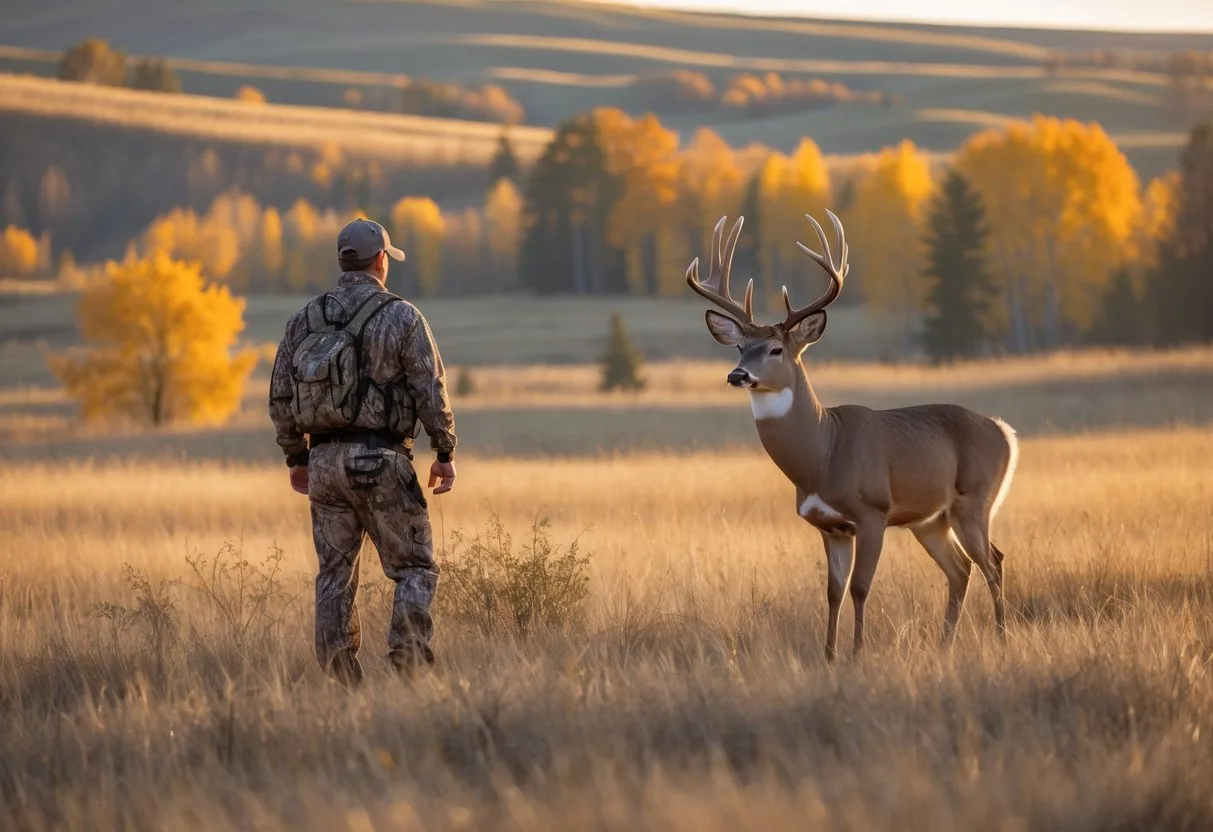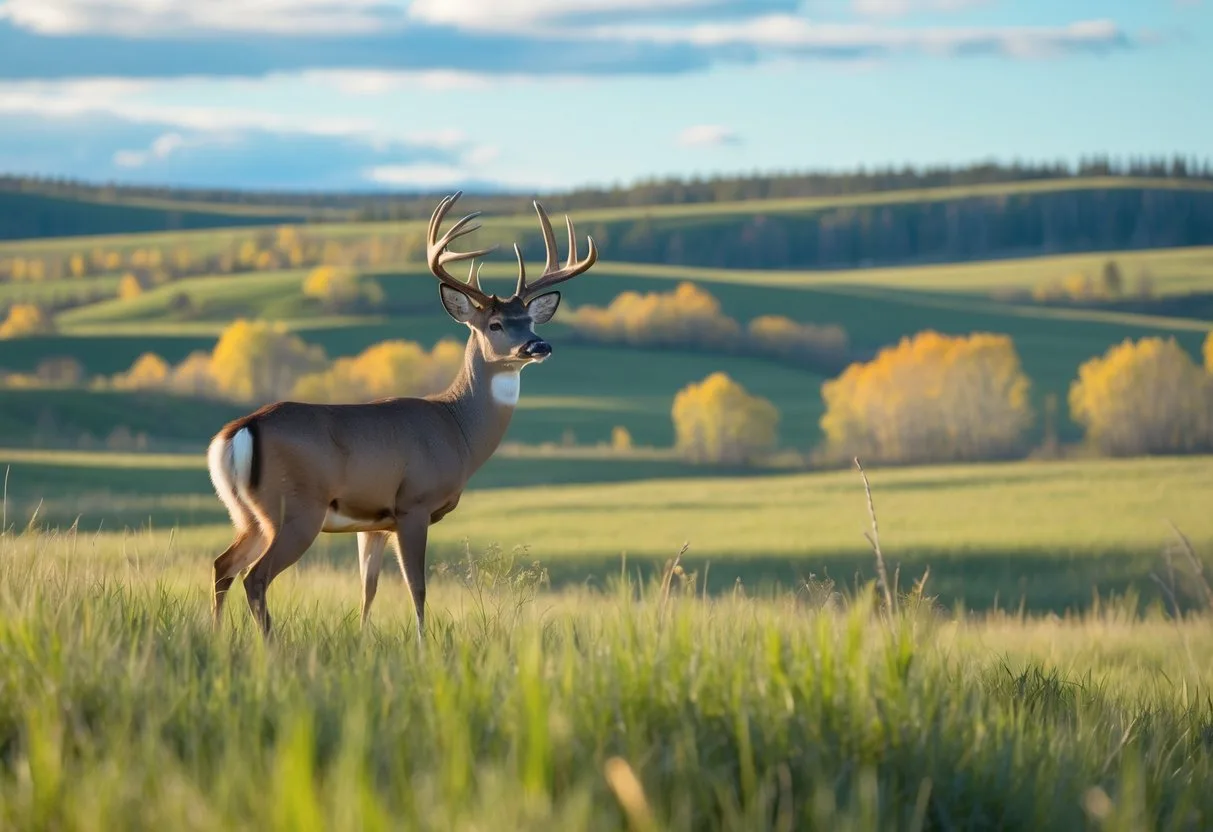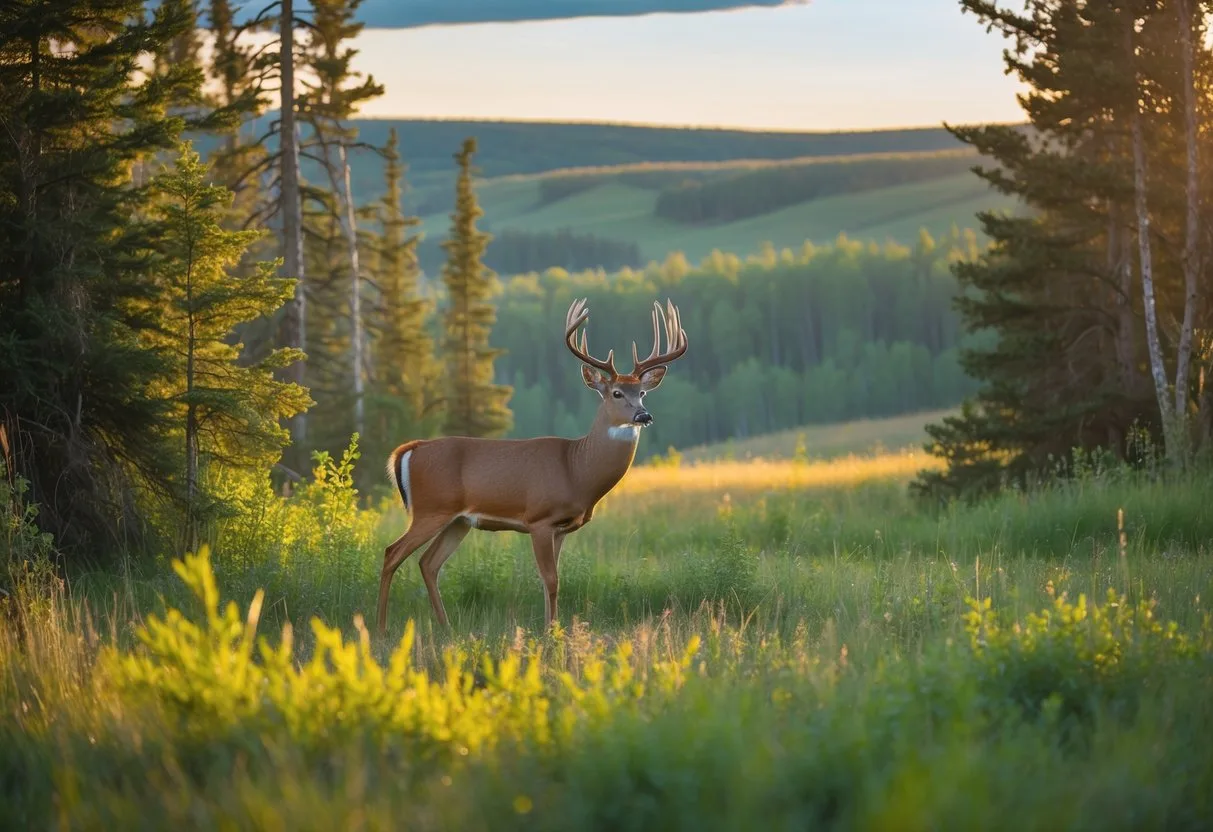Saskatchewan whitetail hunts: Saskatchewan stands out for some of North America’s best whitetail deer hunting. Hunters from all over make the trek up to its sprawling wilderness areas.
The province’s mix of thick boreal forests, farmland, and hunter-friendly regulations set the stage for trophy bucks. It’s a recipe that’s tough to beat if you’re after a big deer.

Saskatchewan whitetail hunts regularly turn up mature bucks scoring 140 inches or more. Outfitters like Otter Creek focus on older, high-scoring deer during their 6-day hunting packages.
The province’s long hunting seasons and healthy deer numbers give both new and seasoned hunters plenty of chances.
Outfitters run operations in nearly every hunting zone, guiding trips across hundreds of thousands of acres. Wheat King Adventures, for example, has access to over 360,000 acres of forest and farmland.
Others stick to hotspots like the Porcupine Provincial Forest, dialing in on areas with the highest odds.
Key Takeaways
- Saskatchewan’s mix of forests and farmland grows trophy whitetail bucks year after year. (Outdoor Life)
- Pro outfitters offer guided hunts with modern gear and seasoned guides across huge territories.
- With patience and planning, hunters can realistically go after mature bucks scoring 140+ inches.
Overview of Saskatchewan Whitetail Hunts

Saskatchewan is famous for producing some of the continent’s heaviest whitetail deer. Bucks here often break 160 Boone and Crockett points.
You’ll find several hunt types spread across huge wilderness tracts. The north, especially, offers pristine conditions if you’re chasing big ones.
Why Saskatchewan Is a Top Destination
The province’s reputation comes from its massive deer population and strong trophy genetics. Over 360,000 acres of territory are managed by professional outfitters.
The climate helps deer grow big. Long, cold winters mean bigger bodies and antlers, and the farmland bordering forests gives deer plenty to eat.
A typical Saskatchewan whitetail hunt runs around $5,400 USD per person, plus taxes and licenses. Most packages cover lodging, meals, and guides.
Deer management programs keep populations healthy. Strict hunting rules allow bucks to reach maturity and ensure sustainable harvests. (The Nature Conservancy)
Types of Whitetail Deer Hunts Offered
Saskatchewan has a few hunting methods to fit your style and skill level. Most hunts run six days during peak season.
Bow hunting starts first. Archery season opens before rifle, so there’s less pressure and more deer movement.
Rifle hunting kicks off in early November and lasts through December. You’ll get longer shots and usually better odds.
Tree stand hunting is the go-to for most folks. Elevated stands give you a clear view and keep your scent above the deer’s nose.
Ground blinds work well in open spots or for hunters who want to stay low-profile. They’re great if you’ve got mobility issues, too.
Most outfitters set up pre-baited stands to draw deer into range.
Hunting in Northern Saskatchewan
Northern Saskatchewan is about as remote as it gets. Thick forests up there make for top-notch deer habitat, far from crowds.
The growing season is long, so there’s plenty of browse and mast for deer to eat. Populations stay strong thanks to limited hunting and careful management.
Getting there isn’t always easy. Sometimes you’ll need a charter flight or a long, bumpy drive down forest roads. Most folks stay in remote lodges with all the basics covered.
The weather? It’s no joke. Temperatures can dip well below freezing, so bring real cold-weather gear.
Northern Saskatchewan gives you a real shot at mature bucks. The remoteness lets deer reach their full size without constant hunting pressure.
Guides know the local deer patterns and movement corridors. Their experience can make all the difference, especially if you’re new to the area. (Field & Stream)
Prime Whitetail Deer Habitat

Saskatchewan’s landscape is a jackpot for whitetail deer. The boreal forests and transition zones next to farmland create the perfect mix of food, cover, and travel routes for trophy-class bucks.
The Boreal Forest Landscape
The forest fringe is where prairie meets dense woods. This area is the most productive for whitetail hunting in Saskatchewan.
Key Habitat Features:
- Mix of timber and farmland
- Thick bedding areas
- Year-round food sources
- Natural travel corridors
The boreal forest gives mature bucks thick cover and security during daylight. Aspen groves, willow patches, and conifers keep them safe from predators and harsh weather.
Nearby agricultural fields mean easy meals. Grain, alfalfa, and leftover crops pull deer out of the woods to feed, especially at dawn and dusk.
Water’s everywhere—streams, wetlands, little lakes. These spots draw deer in and make their movements more predictable.
Deer Behavior and Migration Patterns
Whitetails in Saskatchewan move with the seasons, following food and shelter. Knowing these patterns helps hunters pick the best stands and times.
Seasonal Movement Patterns:
- Early Fall: Deer hit crop fields and edges
- Late Fall: Rut kicks in, movement spikes
- Winter: Deer hunker down in thick woods
Pre-rut starts in October. Bucks set up territory and leave rubs and scrapes. Does usually stick close to home while bucks roam farther for breeding.
November rut changes everything. Bucks move more, even during the day, chasing does and covering way more ground.
Once winter hits and snow piles up, deer head for dense cover. Northern regions turn out the biggest-bodied deer, toughened up by harsh winters. (National Geographic)
Techniques and Methods for Success
Saskatchewan’s thick woods and varied terrain call for the right tactics. Good stand placement, smart scouting, and the right setup can make or break your hunt. Patience matters, too.
Use of Ground Blinds
Ground blinds shine in dense bush country, where baiting with grain or alfalfa is common. They keep you hidden and comfortable, even on long sits.
Set ground blinds 20-30 yards from feeding areas or busy trails. Saskatchewan’s thick brush helps them blend right in.
Ground blind advantages:
- Contain scent well
- Protect from weather
- Let you move quietly
- Store gear easily
It’s best to put up blinds at least a week before hunting. That gives deer time to get used to them. Clear out some shooting lanes and always set up downwind of where you expect deer to come through.
Ground blinds work especially well during the November rut, when bucks are moving more and get a little less wary.
Strategically Placed Tree Stands
Tree stands give you a big advantage in Saskatchewan’s forested areas. Up high, you can spot deer further out and stay above their scent line.
Hang stands 15-20 feet up, along natural funnels between bedding and feeding spots. Creek bottoms, ridges, and field edges are all solid bets.
Tree stand placement tips:
- Stay downwind of trails
- Clear shooting lanes out to 40 yards
- Plan escape routes
- Pick sturdy, mature trees
Late October through early December is prime time for tree stands. Deer change up their routes often, moving between food and breeding areas.
Always use a harness and lifeline for safety. Practice climbing and shooting from height before opening day rolls around.
Scouting and Trail Cameras
Trail cameras are a game-changer for tracking deer movement and numbers. Pre-season scouting helps you find the busiest spots and best stand locations.
Set cameras along funnels, water sources, and feeding areas 4-6 weeks before the season starts. That way, you can spot patterns without spooking deer.
Trail camera tips:
- Mount 8-10 feet up
- Point north to avoid sun glare
- Check once a week before season
- Handle with scent-free gloves
Most Saskatchewan whitetails move at dawn and dusk, but rutting bucks can be active midday, too.
When scouting in person, look for fresh rubs, scrapes, and well-used trails. Fresh sign matters more than old tracks or markings.
Trophy Whitetail Opportunities
Saskatchewan is just built for producing massive trophy whitetails. The genetics are top-notch, and the management is smart. It all adds up to mature bucks with serious antlers.
Genetics and Trophy Potential
Saskatchewan hosts the Dakota strain of whitetail deer, known as the largest whitetail subspecies in North America. These deer carry genetics that lead to impressive body size and antler growth.
Body Weight Characteristics:
- Mature bucks often tip the scales at 230+ pounds.
- Some trophy bucks even break the 300-pound mark.
- Big frames support equally massive antlers.
The whitetail population here benefits from strong genetics and little bottlenecking. Cold Saskatchewan winters favor the survival of larger, tougher deer.
Antler Scoring Statistics:
- Average scores run between 135-150 points.
- About 25% of harvested deer top 160 points.
- 10% of bucks gross over 175 points.
These trophy scoring stats show just how often hunters see Boone and Crockett caliber animals here. With the right genetics and solid habitat, record-book potential is always on the table.
Management Practices and Selective Harvest
Outfitters in Saskatchewan use strict management to keep trophy quality high. Selective harvest strategies focus on mature bucks with minimum scores of 140+ points.
Key Management Strategies:
- Baiting programs (where legal) draw in older deer.
- Trail cameras help spot trophy prospects.
- Selective harvest protects younger bucks.
- Low hunting pressure keeps stress down for deer herds.
Outfitters manage huge wilderness areas with little human disturbance. Some control over 360,000 acres of remote forest plus farmland edges.
Hunter Success Metrics:
- 80% harvest rates on trophy animals.
- Most focus on bucks aged 4.5 years or older.
- Repeat clients suggest consistent quality.
Outfitters, Guides, and Hunting Packages
Saskatchewan outfitters offer full hunting trips with experienced guides, solid accommodations, and all-inclusive packages. Prices usually run from $5,000 to $7,800 USD, covering guided hunts, meals, lodging, and transport.
Selecting a Reputable Outfitter
Outfitters with decades of experience tend to deliver the best trophy whitetail success. Otter Creek Outfitters has guided hunters for over 24 years, producing mature bucks scoring 160+ inches.
Look for outfitters who target mature deer aged 5.5 years or older. These pros manage big territories and stick to selective harvests for trophy quality.
Check out testimonials and return rates—hunters often come back year after year. Some have stuck with the same outfitter for 10-18 straight seasons.
Key factors to evaluate:
- Years in business
- Territory size and exclusivity
- Average buck scores
- Guide-to-hunter ratios
- Equipment quality
Typical Hunt Inclusions
Most Saskatchewan whitetail hunts include six full hunting days, plus arrival and departure. Packages cover meals, private lodging, and guided services.
Transport from airports like Saskatoon to camp is usually included. Hunters often get their own ATV or UTV instead of sharing.
Standard inclusions:
- 6 days of guided hunting
- All meals and lodging
- Transport to and from camp
- Individual hunting vehicles
- Stand placement and upkeep
- Field dressing and processing
Licenses cost about $360 CAD and you’ll buy them on arrival. Most hunts use baited stands in box blinds or heated pop-ups.
Customized Experiences – Saskatchewan Whitetail Hunts
Top outfitters tailor hunts to your needs and physical abilities. Some let you switch between archery and rifle during the same trip.
Camp chefs handle dietary restrictions. Many camps offer private bedrooms and easy-access bathrooms instead of crowded bunkhouses.
Customization options:
- Flexible weapon choice
- Stand height options
- Special dietary menus
- Family accommodations
- Photography services
You can set your own trophy minimums. Guides help you decide which bucks match your goals, using trail cam data and field knowledge.
Essential Logistics and Preparation – Saskatchewan Whitetail Hunts
Planning a Saskatchewan whitetail hunt takes some prep: think licensing, good gear, and knowing your accommodation options. Outfitters usually handle logistics, so you can focus on packing and paperwork.
Booking Requirements and Licensing
Non-residents need a Saskatchewan hunting license before heading out. Expect to pay $100-150 CAD, and you’ll need a hunter safety course from your home province or state.
Bring a valid passport for border crossing. You’ll also need a PAL (Possession and Acquisition License) or a temporary firearms permit to bring guns into Canada.
Required Documentation:
- Valid hunting license
- Passport
- Firearms permit or PAL
- Hunter safety certificate
- Outfitter booking confirmation
Most outfitters ask for a 50% deposit, with the rest due 30-60 days before your trip. Prime dates book up 12-18 months in advance.
Recommended Gear for – Saskatchewan Whitetail Hunts
Good gear makes a huge difference in Saskatchewan’s cold. Temps swing from 20°F to -10°F during peak season.
Essential Gear List:
- Rifle: .270, .30-06, or .300 Win Mag
- Optics: 3-9x scope or better
- Clothing: Insulated boots, thermals, waterproof shell
- Accessories: Hand warmers, headlamp, rangefinder
Layered clothing works best as temps change. Boots rated to -20°F keep your toes intact during long sits.
Most outfitters provide stands and blinds. Bring your favorite calls, scents, and ammo.
Accommodations and Amenities
Saskatchewan outfitters offer everything from basic cabins to luxury lodges. Most camps have heated buildings, hot meals, and gear storage.
Pro operations usually serve three meals a day, comfy beds, and common rooms for relaxing. Some even have Wi-Fi, laundry, and trophy prep services.
Standard Camp Features:
- Heated cabins or lodges
- Family-style meals
- Drying rooms for gear
- Meat processing help
Room sharing is common unless you pay extra for privacy. Most camps run on generators, so power can be limited in the evenings.
Getting to hunting areas depends on the weather—ATV, truck, or snowmobile. Guides handle transport in the field.
Frequently Asked Questions – Saskatchewan Whitetail Hunts
Saskatchewan whitetail hunting always sparks questions about timing, rules, and what to expect. The rut is prime time, but gear and license details vary for residents and visitors.
What is the best time of year to go on a whitetail hunt in Saskatchewan?
The peak rutting season is hands-down the best time for Saskatchewan whitetail hunts. Bucks are most active while chasing does.
The rut usually falls in late October through November. Bucks move more in daylight and respond better to calls then.
You can use doe calls to pull bucks in close. Trail cams before the season help you spot movement patterns and find the best stands.
Are there any specific regulations I need to be aware of when hunting whitetails in Saskatchewan?
Saskatchewan hunting laws cover seasons, bag limits, and gear rules. You’ll need the right licenses before hunting, and bag limits restrict how many deer you can take.
Some weapon restrictions depend on the zone. Each wildlife management area has its own rules and open seasons, so check before you go.
What type of hunting gear is recommended for a Saskatchewan whitetail hunt?
A solid hunting rifle tops the list. Brands like Remington, Winchester, or Browning are all tried-and-true choices.
Binoculars help you glass deer from a distance. A good backpack keeps your stuff organized for long sits.
Camouflage clothing helps you blend in. Sturdy boots are a must for rough terrain.
Trail cameras are handy for scouting before the hunt starts.
Can non-residents apply for whitetail hunting licenses in Saskatchewan, and if so, how?
Non-residents can hunt whitetails in Saskatchewan—no extra hoops to jump through. Just get the required licenses like everyone else.
The process helps manage hunter numbers and keeps things responsible. License fees also support conservation efforts, which is a win for everyone.
Always check the latest requirements and fees before you book. Processing times can vary, so don’t leave it to the last minute.
What is the average size of the whitetail deer population in Saskatchewan’s hunting areas?
Prince Albert National Park is a top spot, with over 3,800 square kilometers of wild habitat. The park holds strong deer numbers across all kinds of terrain.
Mature bucks here can beat 200 pounds, and their antlers often stretch several feet wide. That’s trophy territory for sure.
Forests and open grasslands mix across Saskatchewan, supporting healthy deer populations in every region. For more information on whitetail conservation and hunting, check out resources like the National Wildlife Federation (DA 88) and The Nature Conservancy (DA 91).
What are the success rates for whitetail hunts in Saskatchewan?
Success rates for whitetail hunts in Saskatchewan really depend on the hunter’s skill and the conditions out in the field. Experienced hunters report high success rates in some of the best hunting areas here, which is honestly no surprise.
Trophy-sized bucks are a big draw. Saskatchewan keeps turning out whitetails that easily qualify as trophy animals, and that’s a huge part of the appeal for serious hunters.
Timing matters a lot. Good scouting and picking the right gear also play a huge role in whether you fill your tag or not.
Folks who put in the work—planning, scouting, and gearing up—tend to do better. If you want to dig deeper, check out resources like Outdoor Life or the National Wildlife Federation for more insights from experts.






















